2019 TOYOTA CAMRY HYBRID tow
[x] Cancel search: towPage 3 of 592
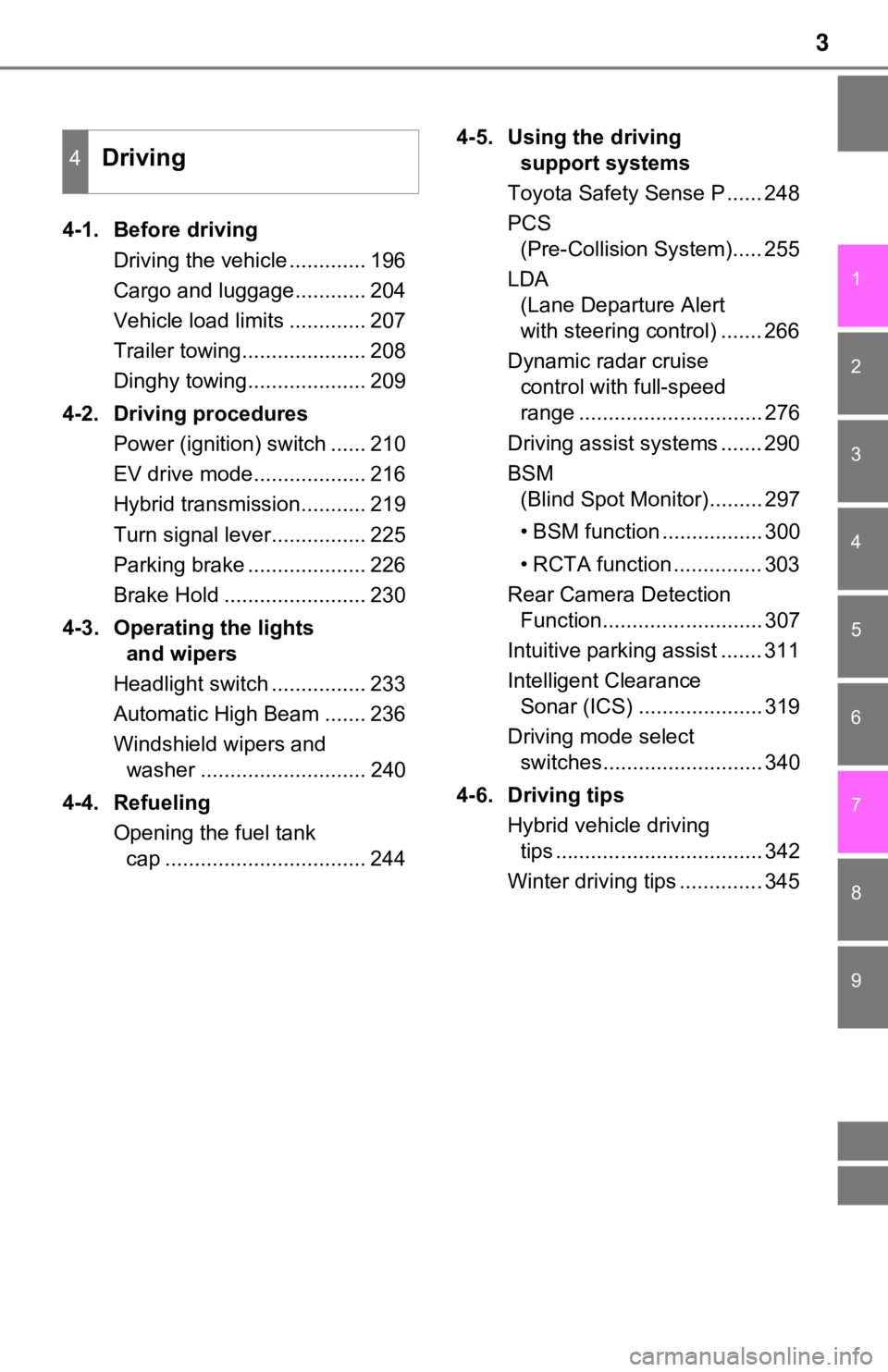
3
1
9 7 6
5
4
3
2
8
4-1. Before drivingDriving the vehicle ............. 196
Cargo and luggage............ 204
Vehicle load limits ............. 207
Trailer towing..................... 208
Dinghy towing.................... 209
4-2. Driving procedures Power (ignition) switch ...... 210
EV drive mode................... 216
Hybrid transmission........... 219
Turn signal lever................ 225
Parking brake .................... 226
Brake Hold ........................ 230
4-3. Operating the lights and wipers
Headlight switch ................ 233
Automatic High Beam ....... 236
Windshield wipers and washer ............................ 240
4-4. Refueling Opening the fuel tank cap .................................. 244 4-5. Using the driving
support systems
Toyota Safety Sense P ...... 248
PCS (Pre-Collision System)..... 255
LDA (Lane Departure Alert
with steering control) ....... 266
Dynamic radar cruise control with full-speed
range ............................... 276
Driving assist systems ....... 290
BSM (Blind Spot Monitor)......... 297
• BSM function ................. 300
• RCTA function ............... 303
Rear Camera Detection Function........................... 307
Intuitive parking assist ....... 311
Intelligent Clearance Sonar (ICS) ..................... 319
Driving mode select switches........................... 340
4-6. Driving tips Hybrid vehicle driving tips ................................... 342
Winter driving tips .............. 345
4Driving
Page 5 of 592
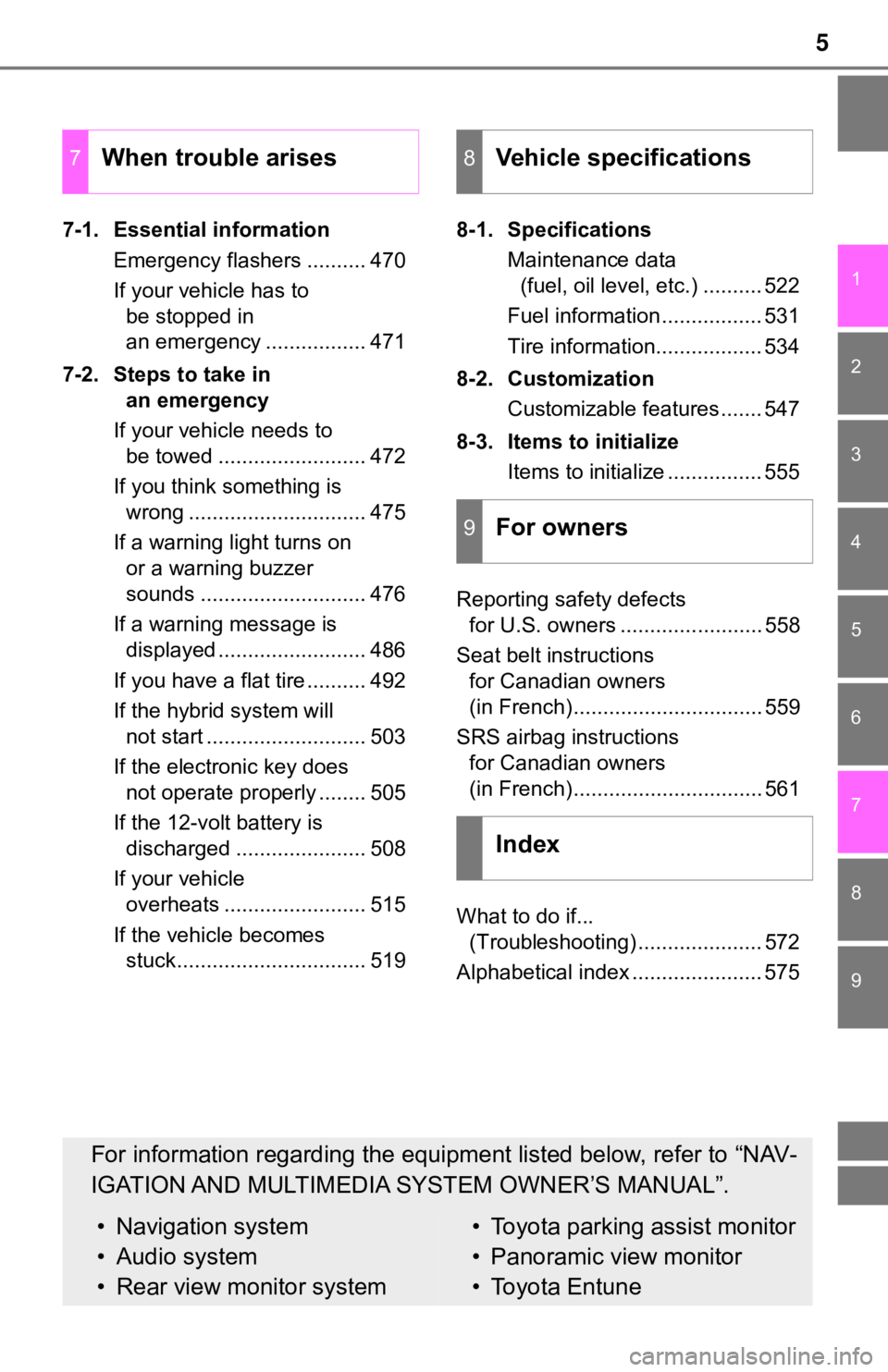
5
1
9 7 6
5
4
3
2
8
7-1. Essential informationEmergency flashers .......... 470
If your vehicle has to be stopped in
an emergency ................. 471
7-2. Steps to take in an emergency
If your vehicle needs to be towed ......................... 472
If you think something is wrong .............................. 475
If a warning light turns on or a warning buzzer
sounds ............................ 476
If a warning message is displayed ......................... 486
If you have a flat tire .......... 492
If the hybrid system will not start ........................... 503
If the electronic key does not operate properly ........ 505
If the 12-volt battery is discharged ...................... 508
If your vehicle overheats ........................ 515
If the vehicle becomes stuck................................ 519 8-1. Specifications
Maintenance data (fuel, oil level, etc.) .......... 522
Fuel information ................. 531
Tire information.................. 534
8-2. Customization Customizable features ....... 547
8-3. Items to initialize Items to initialize ................ 555
Reporting safety defects for U.S. owners ........................ 558
Seat belt instructions for Canadian owners
(in French)................................ 559
SRS airbag instructions for Canadian owners
(in French)................................ 561
What to do if... (Troubleshooting) ..................... 572
Alphabetical index ...................... 575
7When trouble arises8Vehicle specifications
9For owners
Index
For information regarding the equipment listed below, refer to “NAV-
IGATION AND MULTIMEDIA SYSTEM OWNER’S MANUAL”.
• Navigation system
• Audio system
• Rear view monitor system• Toyota parking assist monitor
• Panoramic view monitor
• Toyota Entune
Page 16 of 592
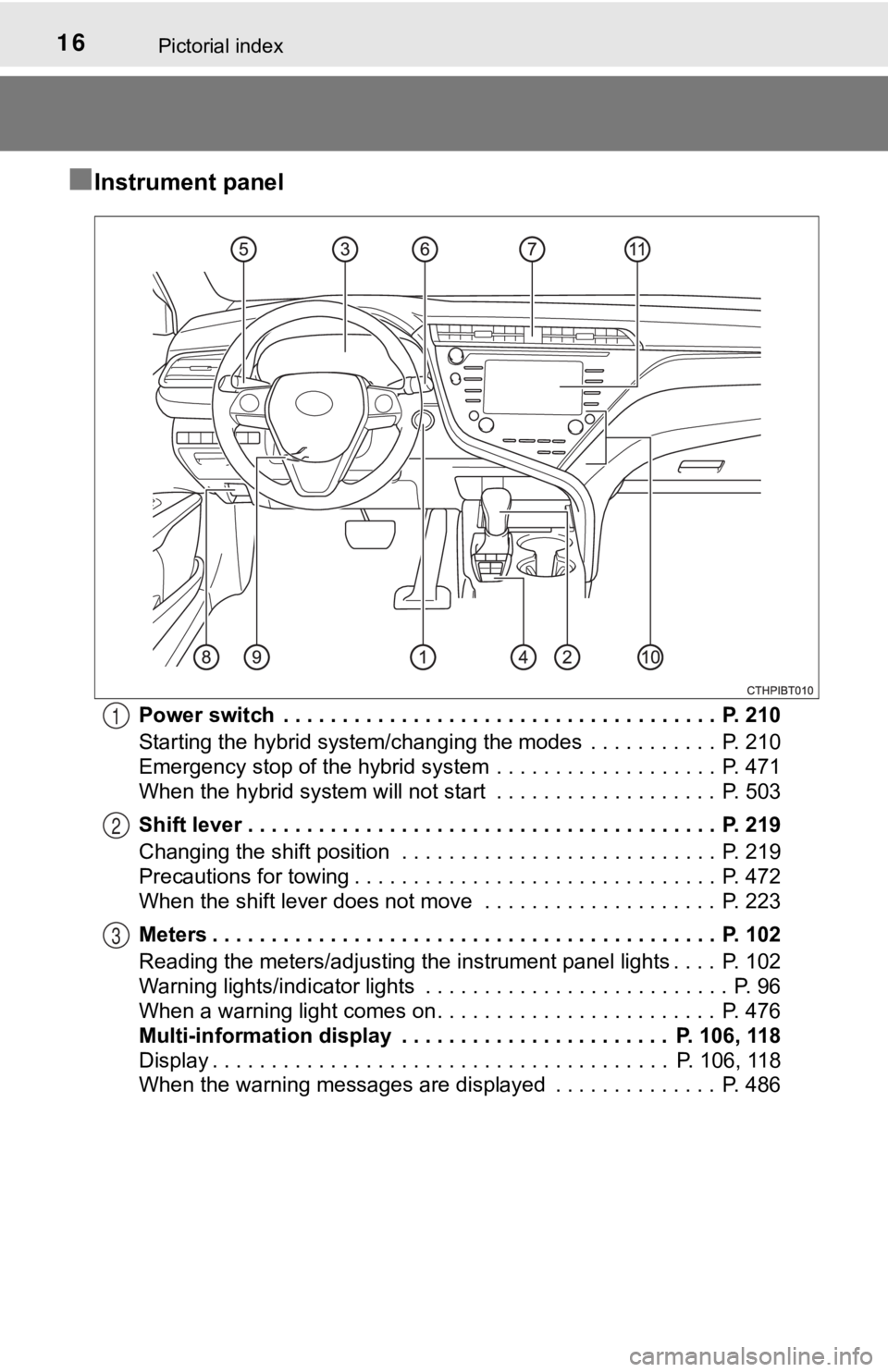
16Pictorial index
■Instrument panel
Power switch . . . . . . . . . . . . . . . . . . . . . . . . . . . . . . . . . . . . . P. 210
Starting the hybrid system/changing the modes . . . . . . . . . . . P. 210
Emergency stop of the hybrid system . . . . . . . . . . . . . . . . . . . P. 471
When the hybrid system will not start . . . . . . . . . . . . . . . . . . . P. 503
Shift lever . . . . . . . . . . . . . . . . . . . . . . . . . . . . . . . . . . . . . . . . P. 219
Changing the shift position . . . . . . . . . . . . . . . . . . . . . . . . . . . P. 219
Precautions for towing . . . . . . . . . . . . . . . . . . . . . . . . . . . . . . . P. 472
When the shift lever does not move . . . . . . . . . . . . . . . . . . . . P. 223
Meters . . . . . . . . . . . . . . . . . . . . . . . . . . . . . . . . . . . . . . . . . . . P. 102
Reading the meters/adjusting the instrument panel lights . . . . P. 102
Warning lights/indicator lights . . . . . . . . . . . . . . . . . . . . . . . . . . P. 96
When a warning light comes on . . . . . . . . . . . . . . . . . . . . . . . . P. 476
Multi-information display . . . . . . . . . . . . . . . . . . . . . . . P. 106, 118
Display . . . . . . . . . . . . . . . . . . . . . . . . . . . . . . . . . . . . . . . P. 106, 118
When the warning messages are displayed . . . . . . . . . . . . . . P. 4861
2
3
Page 37 of 592

371-1. For safe use
1
For safety and security
WARNING
■SRS airbag precautions
Observe the following precautions regarding the SRS airbags.
Failure to do so may cause death or serious injury.
● The driver and all passengers in the vehicle must wear their se at belts
properly.
The SRS airbags are supplemental devices to be used with the se at belts.
● The SRS driver airbag deploys with considerable force, and can cause
death or serious injury especially if the driver is very close to the airbag.
The National Highway Traffic Safety Administration (NHTSA) advi ses:
Since the risk zone for the driver’s airbag is the first 2 - 3 in. (50 - 75 mm)
of inflation, placing yourself 10 in. (250 mm) from your driver airbag pro-
vides you with a clear margin of safety. This distance is measured from
the center of the steering wheel to your breastbone. If you sit less than 10
in. (250 mm) away now, you can change your driving position in several
ways:
• Move your seat to the rear as far as you can while still reach ing the ped-
als comfortably.
• Slightly recline the back of the seat. Although vehicle designs vary, many drivers can achieve the 10 in. (250
mm) distance, even with the driver seat all the way forward, si mply by
reclining the back of the seat somewhat. If reclining the back of your
seat makes it hard to see the road, raise yourself by using a f irm, non-
slippery cushion, or raise the seat if your vehicle has that feature.
• If your steering wheel is adjustable, tilt it downward. This points the air- bag toward your chest instead of your head and neck.
The seat should be adjusted as recommended by NHTSA above, whil e
still maintaining control of the foot pedals, steering wheel, and your view
of the instrument panel controls.
Page 39 of 592
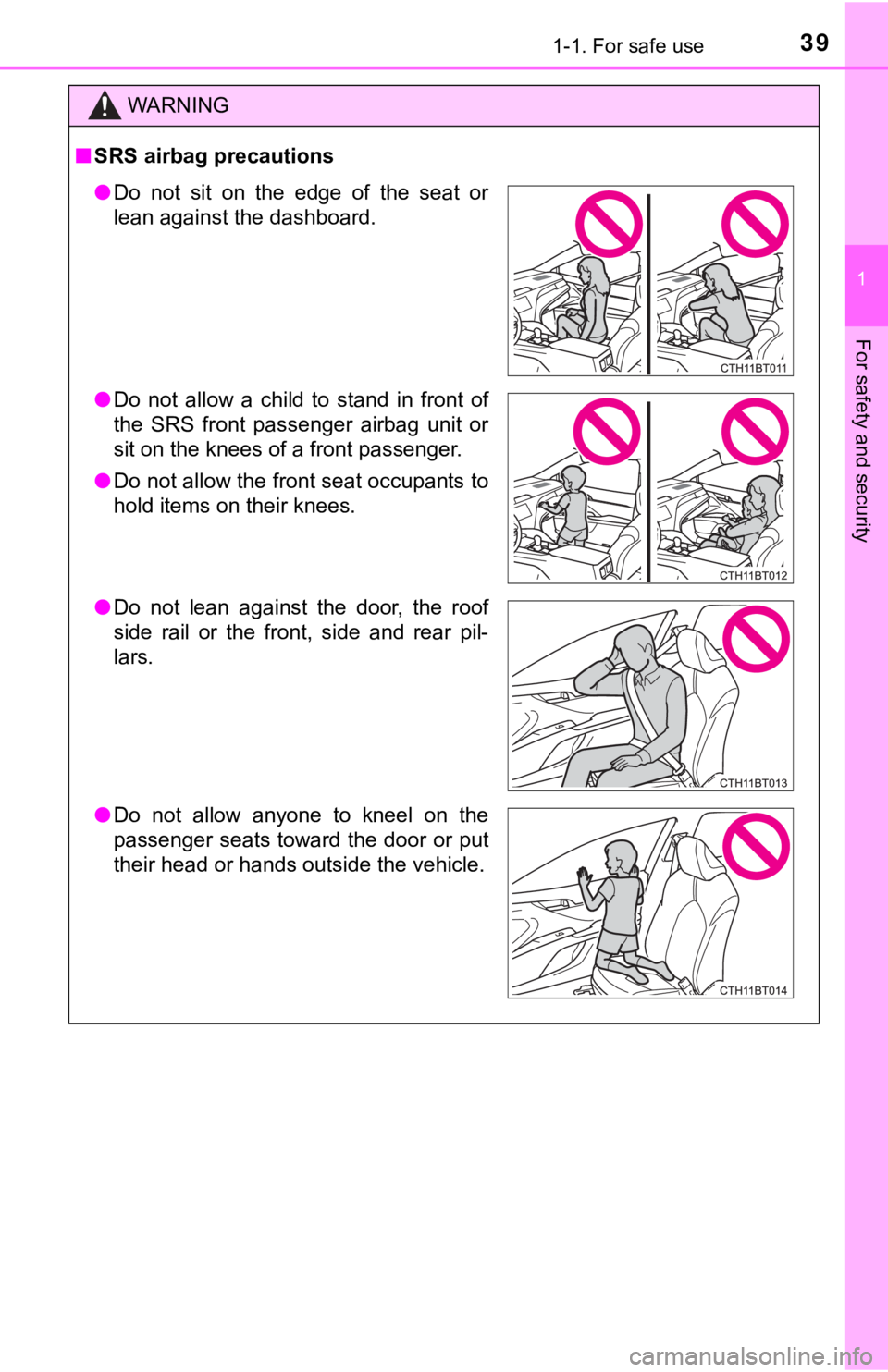
391-1. For safe use
1
For safety and security
WARNING
■SRS airbag precautions
● Do not sit on the edge of the seat or
lean against the dashboard.
● Do not allow a child to stand in front of
the SRS front passenger airbag unit or
sit on the knees of a front passenger.
● Do not allow the front seat occupants to
hold items on their knees.
● Do not lean against the door, the roof
side rail or the front, side and rear pil-
lars.
● Do not allow anyone to kneel on the
passenger seats toward the door or put
their head or hands outside the vehicle.
Page 65 of 592
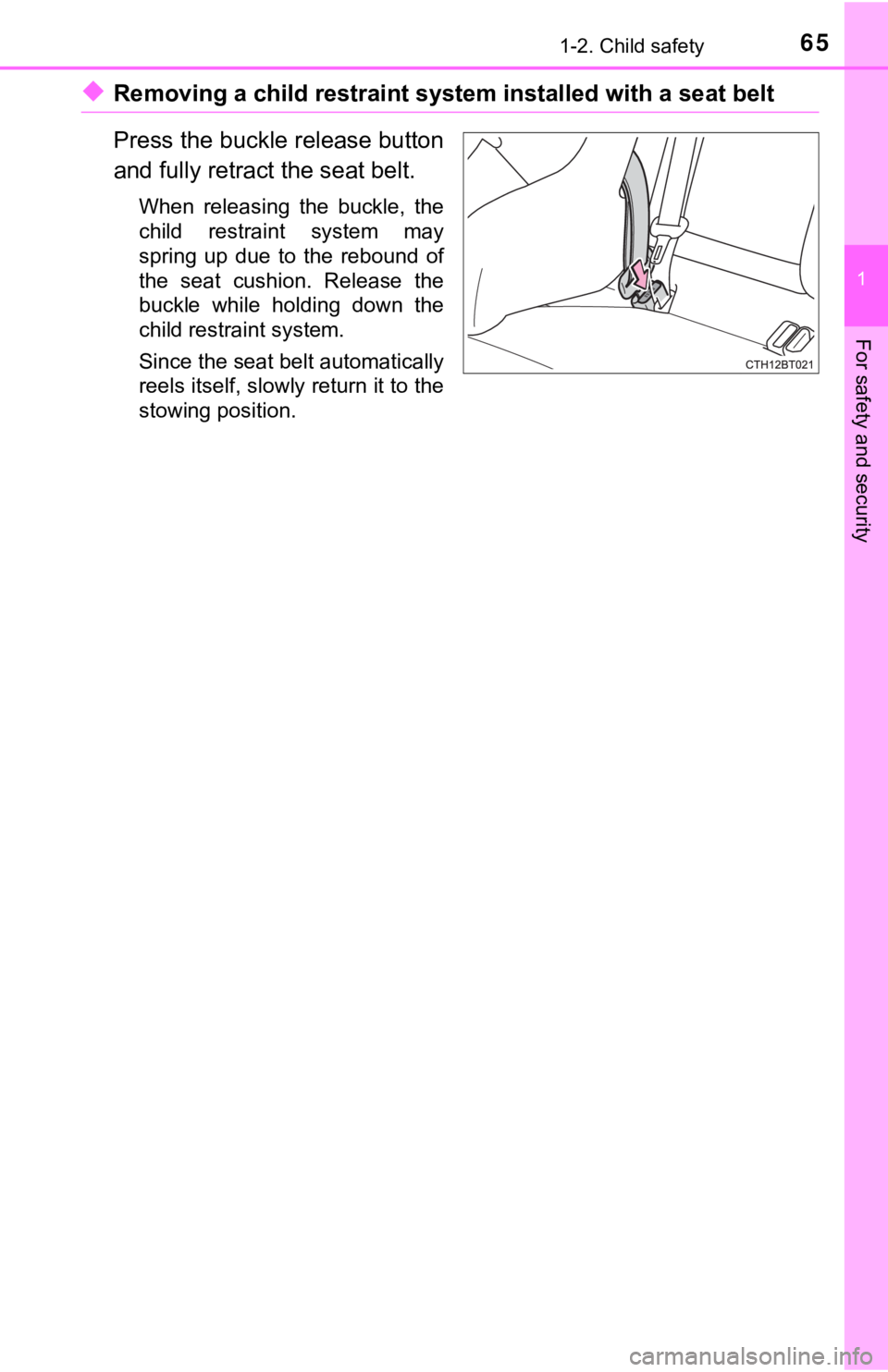
651-2. Child safety
1
For safety and security
◆Removing a child restraint system installed with a seat belt
Press the buckle release button
and fully retract the seat belt.
When releasing the buckle, the
child restraint system may
spring up due to the rebound of
the seat cushion. Release the
buckle while holding down the
child restraint system.
Since the seat belt automatically
reels itself, slowly return it to the
stowing position.
Page 77 of 592
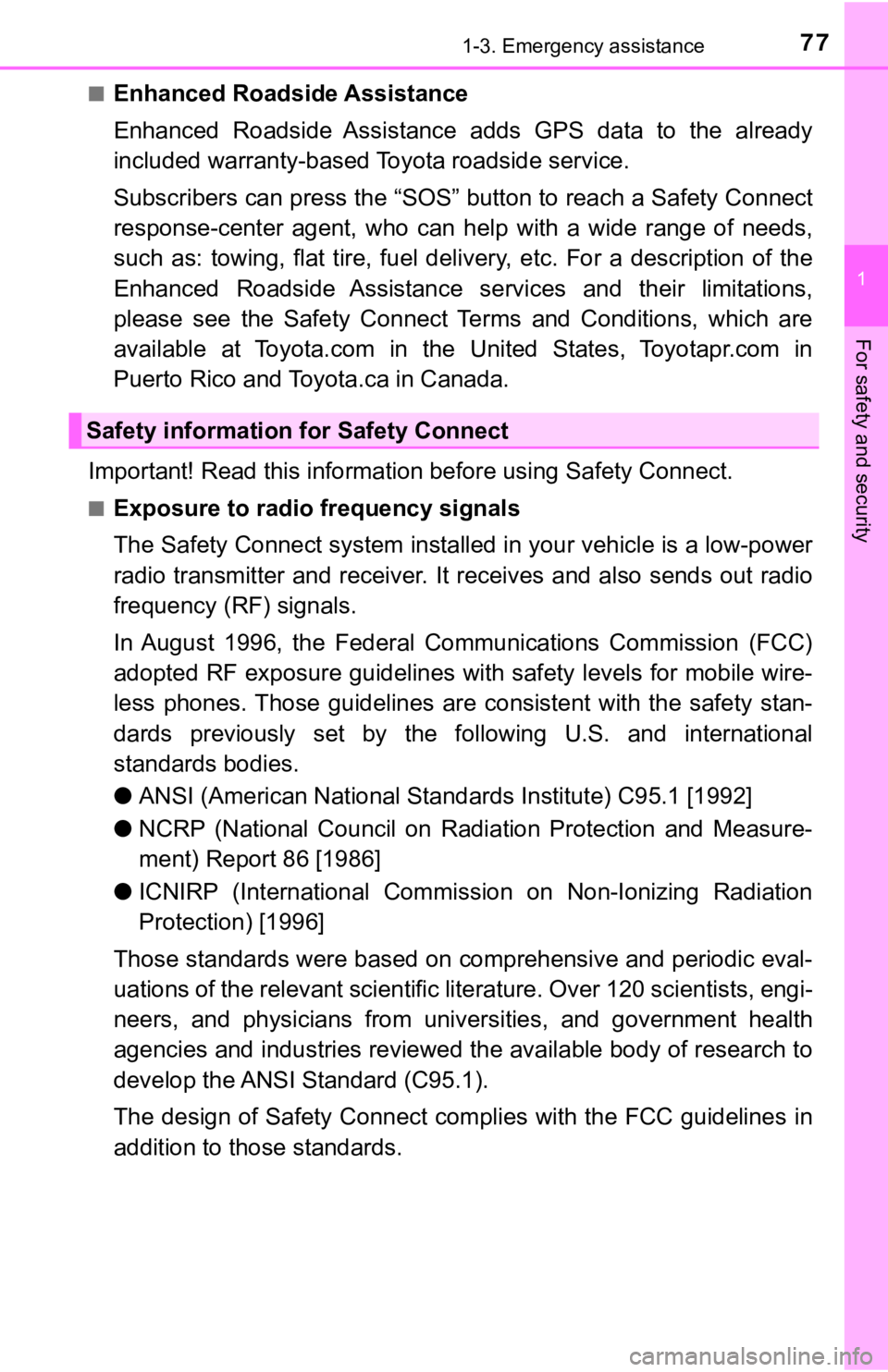
771-3. Emergency assistance
1
For safety and security
■Enhanced Roadside Assistance
Enhanced Roadside Assistance adds GPS data to the already
included warranty-based Toyota roadside service.
Subscribers can press the “SOS” button to reach a Safety Connec t
response-center agent, who can he lp with a wide range of needs,
such as: towing, flat tire, fuel delivery, etc. For a description of the
Enhanced Roadside Assistance se rvices and their limitations,
please see the Safety Connect Te rms and Conditions, which are
available at Toyota.com in the United States, Toyotapr.com in
Puerto Rico and Toyota.ca in Canada.
Important! Read this informatio n before using Safety Connect.
■Exposure to radio frequency signals
The Safety Connect system installed in your vehicle is a low-po wer
radio transmitter and receiver. I t receives and also sends out radio
frequency (RF) signals.
In August 1996, the Federal Communications Commission (FCC)
adopted RF exposure guidelines with safety levels for mobile wi re-
less phones. Those guidelines are consistent with the safety stan-
dards previously set by the following U.S. and international
standards bodies.
● ANSI (American National Stand ards Institute) C95.1 [1992]
● NCRP (National Council on Radi ation Protection and Measure-
ment) Report 86 [1986]
● ICNIRP (International Commission on Non-Ionizing Radiation
Protection) [1996]
Those standards were based on comprehensive and periodic eval-
uations of the relevant scienti fic literature. Over 120 scientists, engi-
neers, and physicians from unive rsities, and government health
agencies and industries reviewed the available body of research to
develop the ANSI Standard (C95.1).
The design of Safety Connect complies with the FCC guidelines i n
addition to those standards.
Safety information for Safety Connect
Page 87 of 592

871-4. Hybrid system
1
For safety and security
WARNING
■Road accident cautions
Observe the following precautions to reduce the risk of death o r serious
injury:
● Pull your vehicle off the road, apply the parking brake, shift the shift lever
to P, and turn the hybrid system off.
● Do not touch the high voltage parts, cables and connectors.
● If electric wires are exposed inside or outside your vehicle, a n electric
shock may occur. Never touch exposed electric wires.
● If a fire occurs in the hybrid vehicle, leave the vehicle as soon as possible.
Never use a fire extinguisher that is not meant for electric fires. Using even
a small amount of water may be dangerous.
● If your vehicle needs to be towed, do so with front wheels raised. If the
wheels connected to the electric motor (traction motor) are on the ground
when towing, the motor may continue to generate electricity. Th is may
cause a fire. ( P. 472)
● Carefully inspect the ground under the vehicle. If you find that liquid has
leaked onto the ground, the fuel system may have been damaged. Leave
the vehicle as soon as possible.
● If electrolyte is leaking from the hybrid battery (traction bat tery), do not
approach the vehicle.
Even in the unlikely event that the hybrid battery (traction ba ttery) is dam-
aged, the internal construction of the battery will prevent a l arge amount
of electrolyte from leaking out. However, any electrolyte that does leak out
will give off a vapor. This vapor is an irritant to skin and ey es and could
cause acute poisoning if inhaled.
AXVH70 model*
● Do not touch the hybrid battery (traction battery) if liquid is leaking from or
adhering to it. If electrolyte (carbonic-based organic electrol yte) from the
hybrid battery (traction battery) comes into contact with the e yes or skin, it
could cause blindness or skin wounds. In the unlikely event tha t it comes
into contact with the eyes or skin, wash it off immediately wit h a large
amount of water, and seek immediate medical attention.
● Do not bring burning or high-tem perature items close to the electrolyte.
The electrolyte may ignite and cause a fire.
*: The model code is indicated on the Certification Label. ( P. 523)
AXVH71 models*
●If a fluid leak occurs, do not touch the fluid as it may be str ong alkaline
electrolyte from the hybrid battery (traction battery). If it c omes into contact
with your skin or eyes, wash it off immediately with a large am ount of water
or, if possible, boric acid solution. Seek immediate medical at tention.
*: The model code is indicated on the Certification Label. (P. 523)